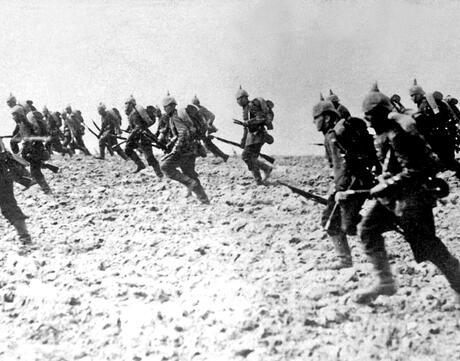
World War I and Its Aftermath in Germany
Duration
Two 50-min class periodsSubject
- History
- Social Studies
Grade
6–8Language
English — USPublished
In this lesson
Overview
About This Lesson
In this lesson, students will begin to examine how the facets of human behavior they have learned about in previous lessons—including stereotypes, prejudice, racism, and antisemitism—influenced people and events in this unit’s historical case study: Nazi Germany and the Holocaust. They will begin the case study by exploring some of the brutal realities of World War I, unexpected to most nations when they joined the war. They will also learn about Germany’s surrender in 1919 and the terms imposed on it by the Treaty of Versailles, both of which shocked Germans and contributed to conditions that would provide fertile ground for the rise of the Nazi Party in the decade that followed.
Unit Essential Question: What does learning about the choices people made during the Weimar Republic, the rise of the Nazi Party, and the Holocaust teach us about the power and impact of our choices today?
- How was the reality of World War I different from what many people and nations expected?
- How did World War I end for Germany, and how did Germans respond to the war’s aftermath?
- Students will be able to explain how the brutal realities of World War I conflicted with the expectations of quick victory shared by many nations.
- Students will be able to explain why the Treaty of Versailles shocked and upset many Germans.
This lesson is designed to fit into two 50-min class periods and includes:
- 5 activities
- 4 teaching strategies
- 2 readings,
- 2 assessments
- 3 extension activities
The history of World War I shows how the ways in which societies define “we” and “they” can help to precipitate war. To understand how this dynamic played out in the buildup to World War I, one must consider the ideology of nationalism and the theory of Social Darwinism. In the 1800s, the biological view of race shaped how many Europeans and Americans defined the word nation. Members of a nation shared not only a common history, culture, and language but also common ancestors, character traits, and physical characteristics. Many believed, therefore, that a nation was a biological community. Nationalists believed that their biological communities—their nations—were inherently superior to others. Through the practice of eugenics, nations sought to promote the health of their biological communities and protect them from “threat,” which they often defined as mixing with other, allegedly inferior, “races.”
How could a nation demonstrate its superiority to other nations? In the late 1800s, the answer to that question was increasingly demonstrated through competition and conflict. After Charles Darwin published his theory of evolution in 1859, many Europeans and Americans began to apply his ideas about natural selection to human society. The result was the theory of Social Darwinism and its belief in the “survival of the fittest.” Social Darwinists believed that people who were at the top of the social and economic pyramid were society’s fittest. People at the bottom must be “unfit,” they reasoned, because competition rewards “the strong.”
Inspired by the desire to prove that their societies were the “fittest” and enrich themselves in the process, European nations set out to extend their empires around the turn of the twentieth century throughout Africa and Asia. To sustain this imperialism, nations devoted more and more men and resources to their armies and navies. As militaries became more powerful and competition increased between European nations, they began to form military alliances to ensure that they had the necessary support to fend off rival nations in case war broke out.
It was in this context that the 1914 assassination of the Austrian archduke Franz Ferdinand in Sarajevo, by a Serbian nationalist, set off the series of events that engulfed the world in war. In response to the assassination, Austria-Hungary invaded Serbia. Soon after, Russia (Serbia’s ally) and Germany (Austria-Hungary’s ally) declared war on each other. Other nations, including France, England, and the Ottoman Empire, entered the hostilities soon after that.
World War I would eventually involve 30 nations and 65 million soldiers. It was a war with incredible loss of human life on every battlefront and huge damage to the land wherever fighting occurred—a conflict marked by genocide, civil wars, famines, and revolutions. By its end, more than 9 million soldiers and more than 5 million civilians had been killed. As a result of the war, three European empires fell (the German, Austro-Hungarian, and Ottoman), causing panic and displacement for millions of people.
This lesson explores the effect of World War I on Germany and how its aftermath created conditions that helped give rise to the Nazis in the years that followed. Historian Doris Bergen writes that while World War I did not cause Nazism or the Holocaust, its aftermath left in place fertile ground for the history that followed in at least three ways:
- The destruction and brutality of World War I “seemed to many Europeans to prove that human life was cheap and expendable.”
- The trauma of World War I created in Europeans and their leaders a “deep fear of ever risking another war.”
- The war’s resolution left in place across Europe lingering resentments about the war and the terms of the peace. These resentments would later prove useful to leaders such as Adolf Hitler who sought to create “a politics of resentment that promoted a bitter sense of humiliation.” 1
- 1Doris L. Bergen, War and Genocide: A Concise History of the Holocaust, 3rd ed. (Lanham: Rowman & Littlefield, 2016), 42–43. Reproduced by permission from Rowman & Littlefield Publishing Group.
Preparing to Teach
A Note to Teachers
Before teaching this lesson, please review the following information to help guide your preparation process.
The activities in this lesson introduce students to the effects of World War I, a pivotal event in world history and one that was instrumental in creating some of the conditions for the Holocaust. To access students’ prior knowledge about World War I and encourage active reading, this lesson utilizes the K-W-L literacy strategy. In the first activity, you’ll create a K-W-L chart for World War I on chart paper, and over the course of this lesson the class will likely generate more questions in the “W” column than they will be able to answer in this lesson and unit. Consider posting the chart in a prominent place in your classroom and advising students to return to it as questions (or answers) arise. You may also want to encourage students to explore the activities in the Extensions section if they would like to research the topic further.
If, in your planning, you decide that you need to abbreviate this lesson, you can meet the lesson’s learning objectives by creating only a class K-W-L chart (rather than having each student complete one), or by adjusting the lesson to omit the chart entirely.
Related Materials
The following are key vocabulary terms used in this lesson:
- Patriotism
- Nationalism
- Armistice
- Treaty
Add these words to your Word Wall, if you are using one for this unit, and provide necessary support to help students learn these words as you teach the lesson.
Related Materials
World War I is a substantial historical topic, one to which an entire unit could be devoted. The extensions to this lesson can be used to help review the causes and outcome of the war with older students, or to introduce them to these topics if they have not learned about the war before. Chapter 3 of Holocaust and Human Behavior includes additional resources about World War I, its impact on the home fronts, and its aftermath.
Related Materials
Lesson Plans
Day 1
Activities
- Begin the lesson by asking students to respond to the following prompt in their journals:
What are some ways that people express pride in their country? What are the benefits of patriotism? Can feelings of national pride ever go too far? If so, how? Have students discuss their responses using the Think, Pair, Share strategy. - Explain to students that the countries that fought in World War I were motivated by a belief that the people of their nations were superior to the people of the nations they fought. This is a more extreme form of patriotism called nationalism, and, like racism, it involves the belief that one group of people is distinct from and superior to another.
- Before delving into more detail about the war, briefly discuss the following question with students: How does war affect people’s feelings of pride in and loyalty toward their country? Make sure students understand that war almost always amplifies people’s feelings of loyalty toward their country.
Related Materials
Students may or may not know much about World War I at the beginning of this lesson. By examining a map of Europe and the Middle East during World War I, students can learn some basic facts about the war.
- Have students draw a blank, three-column K-W-L chart in their journals. Also create a blank class K-W-L chart on the board or a piece of chart paper. Add “World War I: 1914–1918” to the class chart, and have students copy the same into their journals.
- Pass out the map World War I in Europe and the Middle East. Lead students through an analysis of the map to gather some basic facts using the questions below. While you record basic facts in the “Know” column on the class K-W-L chart, students can record them in the same column in their journals:
- What information does the map provide about the two sides that fought the war? What was each side called? What countries and empires were part of each side?
- What does the map suggest about where most of the fighting in the war took place in Europe?
- What else does the map suggest about the story of World War I?
- After gleaning basic facts about the war from the map, have students take a few minutes to add questions to the “Want to Know” column of their K-W-L charts.
- Use the Think, Pair, Share strategy to have students share their questions, first with a partner and then with the entire class.
- Tell students that since World War I is such a pivotal event in world history, over the course of this lesson the class will likely generate more questions in the “W” column of the K-W-L chart than they will be able to answer in this lesson and unit.
One of the reasons World War I had such a profound impact on the history that followed was because victory was far more difficult to achieve and the fighting was far more brutal than most leaders and people of the nations involved (who all believed in their own superiority) expected. The reading The Brutal Realities of World War I, includes data about the military deaths and casualties suffered by each country in the war, offering one way to get a sense of the profound impact the war had on the world.
- Pass out the reading The Brutal Realities of World War I. Also project it at the front of the room, if possible. Read aloud the introductory paragraphs.
- If necessary, take a few minutes to practice with students how to read the chart and extract data. To do so, you might ask students to answer specific questions (for example: How many French soldiers were wounded in the war?). After each question, choose a student to walk up to the screen, if you are projecting the chart for the class, and show how he or she found the answer. You might also ask students to use the map World War I in Europe and the Middle East to locate countries listed in the chart (note that some countries are not included on the map).
- Next, give students time to look closely at the casualty chart and complete a 3-2-1 exercise using the following guidelines:
- Write down 3 numbers from the chart that seem significant to you, and explain why.
- Write down 2 questions about World War I that the data in this chart raise for you.
- Come up with 1 hypothesis, based on the chart, about how World War I affected people in Germany and other European nations in the decade that followed.
- Have students share their 3-2-1 responses with a partner before debriefing with the entire class.
- Return to the K-W-L chart. Ask students to contribute any new conclusions about World War I that they can add to the “L” column. Also, ask students to suggest new questions for the “W” column that this activity raised for them. As you add new items to the class chart, students should copy them into their journals.
Day 2
Activities
- Explain to students that even though an armistice (truce) ended fighting on November 11, 1918, the war was not officially over until a treaty was signed. The Allies determined the terms of the treaty in negotiations in 1919, and Germany and other Central powers had no choice but to sign the treaty in 1920.
- Before looking at some details about the Treaty of Versailles, pause to ask students to reflect on the purposes of a treaty to end a war. Have students respond to the following question in their journals and then discuss their responses with a partner:
- To what are the victors entitled at the end of a war? How should the countries that surrendered and lost a war be treated?
- Pass out the reading Negotiating Peace, containing excerpts from the Treaty of Versailles. Read the excerpts from the treaty either individually or as a class. Next, have students respond to the following questions in their journals and then discuss their answers with the same partner from the previous journal exercise:
- Based on the information you have about the Treaty of Versailles, what do you think its goals were?
- Who benefited from the treaty? How? Who was harmed by the treaty? How?
- Do you think the treaty was fair?
- Have each student re-read the handout and write a newspaper headline, in 15 words or less, that summarizes the impact of the Treaty of Versailles on Germany. Invite students to share and discuss their headlines using the Wraparound teaching strategy.
- Return one final time to the K-W-L chart. Ask students to contribute any new conclusions about World War I that they can add to the “L” column. Also, ask students to suggest new questions for the “W” column that this activity raised for them. As you add new items to the class chart, students should copy them into their journals.
Related Materials
End the lesson with another brief discussion about patriotism, national pride, and nationalism. In particular, ask students to respond to the following question in their journals:
How do you think the outcome of World War I and the Treaty of Versailles might have affected Germans’ feelings about their nation? How might people respond to evidence that their belief in their nation’s superiority is wrong?
Assessment
- Examine students’ K-W-L charts to see how their thinking and understanding evolved over the course of the lesson.
- Evaluate students’ headlines about the Treaty of Versailles to look for evidence of their understanding of the war, the treaty, and the impact on Germany. You can either listen to the headlines as students share them in the Wraparound activity or you can ask students to turn them in on a notecard.
Extension Activities
To deepen students’ understanding of the world-historical scope of this conflict, consider selecting one or more of the following activities to add to this lesson or assign as homework.
The reading The Beginning of World War I introduces some important factors that helped lead to the war (and continued to affect Europe and the rest of the world after the war), and it describes the event that ignited the fighting.
Consider reading the overview aloud with the class, pausing so that students can locate the following places on the map World War I in Europe and the Middle East: Great Britain, Germany, Austria-Hungary, Russia, France, Serbia, and Sarajevo.
After you finish reading, ask students to use the information in it to write working definitions of militarism, nation, and military alliance in their journals. Then discuss how each of those factors (militarism, nations, and alliances) contributed to the outbreak of World War I.
Related Materials
Activity 2 (Day 1) above provides one way to get a sense of the brutality of World War I—through statistics. Firsthand accounts of the battlefield, paintings by soldiers and observers, and literary responses to the war provide other avenues for learning about the profound impact of the war on the bodies and minds of those who experienced it. The following resources provide a sampling of these kinds of responses to the war:
- Image: John Singer Sargent, Gassed, 1917
- Image: Otto Dix, Wounded Soldier, 1924
- Reading: Disillusion on the Battlefield
You can have students analyze and discuss these resources using the Jigsaw strategy. Use the following question to focus their analysis: What does this text or image suggest about the impact, physical and emotional, that World War I had on its creator and on the world in general?
The signing of the armistice shocked many Germans. It gave rise to the dangerous assertion that Germany’s new leaders, as well as socialists and Jews, had “stabbed Germany in the back” when they signed the armistice. The reading Signing the Armistice explores the terms of the agreement and the vicious rumors that swirled in its wake.
Related Materials
Materials and Downloads
Explore the Materials
World War I in Europe and the Middle East
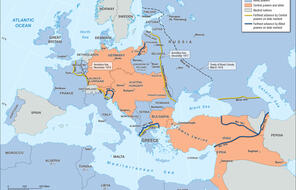
The Brutal Realities of World War I
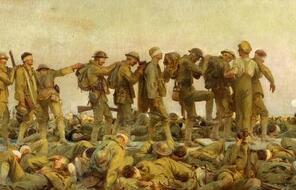
Negotiating Peace
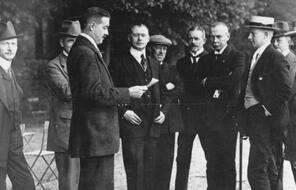
For Educators in Jewish Settings: Teaching Holocaust and Human Behavior
You might also be interested in…
The Refugee Crisis and 1930s America
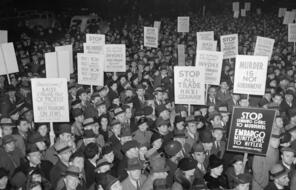
Refugees and Rescuers: The Courage to Act
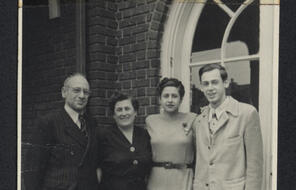
Confronting Genocide Denial

European Jewish Life before World War II
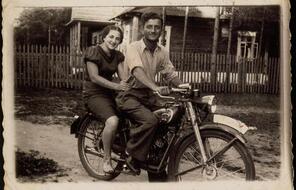
Introducing the Unit

Nationalism and the Aftermath of World War I

The Rise of Nationalism and the Collapse of the Ottoman Empire
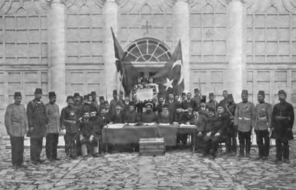
The Rise of the Nazi Party

Survivor Testimony and the Legacy of Memory

Materials for Teaching Holocaust and Human Behavior

Pre-War Jewish Life in North Africa
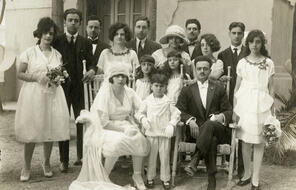
Responses to Rising Antisemitism and Antisemitic Legislation in North Africa
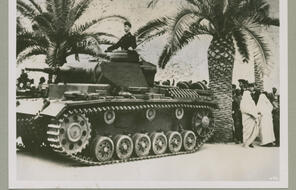
Unlimited Access to Learning. More Added Every Month.
Facing History & Ourselves is designed for educators who want to help students explore identity, think critically, grow emotionally, act ethically, and participate in civic life. It’s hard work, so we’ve developed some go-to professional learning opportunities to help you along the way.
Exploring ELA Text Selection with Julia Torres
On-Demand

Working for Justice, Equity and Civic Agency in Our Schools: A Conversation with Clint Smith
On-Demand

Centering Student Voices to Build Community and Agency
On-Demand


